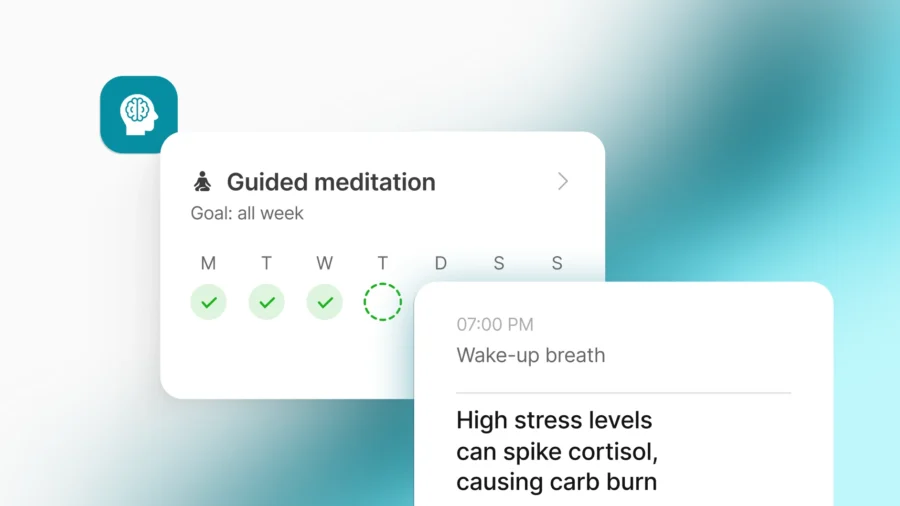Why metabolic health matters

Getting to the root cause
Within every person, there is a well of energy just waiting to be activated. The mitochondria, the powerhouses of your cells, are the source of this energy. They take the carbs and fats you eat and turn them into fuel to power your everyday life1. The healthier they are, the more energy you can produce in each moment, as efficiently as possible. And the easier your mitochondria can switch between burning carbs or fats for fuel, the more metabolically flexible you’ll be23. This also means better sleep, enhanced athletic performance, and weight loss.
Yet so many people worldwide go from energy drinks to sleeping pills to yo-yo dieting as band-aid approaches for excess weight, chronic fatigue, and poor sleep and end up being treated by doctors only once they have metabolic disorders like pre-diabetes and insulin resistance. Modern medicine often treats these issues in isolation while overlooking their root cause of metabolic inflexibility.

There is so much untapped potential for how great you can feel in your body, and it all begins with metabolic health. It is fundamental to feeling your best because it flips on the power switch of your mitochondria and gets to the root cause of imbalances in your body.
How metabolic flexibility can transform your well-being
Understanding your metabolism, how it functions, and what could be helping or harming it will empower you to make decisions and lifestyle changes that can benefit your overall health for life. Let’s dive deeper into why metabolic health matters.
Easier weight management
When you’re metabolically flexible, your mitochondria more readily burn fat at rest and low-intensity workouts and switch to carb burn after eating or when you need a burst of energy, as with high-intensity exercise or stressful situations. This means easier weight loss and weight management because your mitochondria’s ability to use stored fat as an energy source is optimized, plus, they burn carbs immediately after a meal instead of converting them to fat.
Lumen research shows that metabolic flexibility is linked to individuals with a healthy BMI, as they can efficiently use carbs post-meal2. For obese people looking to lose weight, improving metabolic flexibility can be the key to reaching fat burn and efficiently burning food consumed at meals.
Mitochondrial support tip:
Balancing your glycogen levels – your body’s reserve carb storage – is key. Glycogen is useful because it can quickly break down into glucose for fuel, especially during high-intensity exercise or between meals, to give you a quick energy boost.
Too-low glycogen makes us feel tired and sluggish, whereas overloaded glycogen storage brought on by excess carb consumption overworks the mitochondria and causes oxidative stress. It also makes the mitochondria over-reliant on carbs for energy and reduces their ability to use fat for fuel, leading to reduced fat burn. Obese individuals, specifically, have been shown to have poor glycogen synthesis, which negatively impacts glucose metabolism2.

To optimize your glycogen storage, track your carbs and meal timing. This helps ensure you don’t overconsume or underconsume carbs. Once you become aware of your carb intake, you can time it so you eat most of your carbohydrates earlier in the day or before physical activities.
“Knowing whether your body is burning fat or burning carbs is a process called biofeedback. If you don’t know if you’re doing things right or wrong, you’re never going to improve.”
Dr. Jason Fung
Optimized athletic performance
Your mitochondria’s ability to easily shift between carb and fat burn means you’ll use the right fuel source to support low-intensity and high-intensity exercise. It also translates to more energy for your workouts and better endurance and athletic performance. Higher metabolic flexibility even improves recovery, as it promotes better insulin sensitivity, which helps shuttle glucose to your muscles post-workout.
Mitochondrial support tip:
Your muscles are packed with mitochondria and house most of your glycogen. This means the more muscle mass you gain, the more mitochondria and glycogen stores you’ll have.
As a result, your muscles can efficiently use carbs when you need an energy boost, ensuring less glucose is stored as fat. It also helps your mitochondria better metabolize fat at rest or during low-intensity activities.
You can boost your muscle mass growth by following a consistent weightlifting plan, eating adequate amounts of protein, and fueling up before resistance training sessions to avoid muscle breakdown3.
Preventing metabolic disorders and promoting longevity
More than half a billion people live with diabetes worldwide, affecting men, women, and children of all ages in every country. This number is expected to more than double to 1.3 billion people in the next 30 years, with every country seeing an increase. Metabolic flexibility reduces the risk of several metabolic disorders, type 2 diabetes, and non-alcoholic fatty liver disease3.

Studies have shown that poor mitochondrial health often precedes insulin resistance, which occurs when your cells don’t respond to insulin, underlining mitochondria’s significant role in metabolic health4. Insulin resistance leaves more glucose in the bloodstream, signaling the body to store it as fat, which can contribute to unwanted weight gain and metabolic syndrome.
Mitochondrial support tips:
Balancing carb intake to properly fuel the mitochondria while not causing them to become overdependent on carbs is crucial. It’s also important to mind the quality, quantity, and timing of your carbs so they don’t chronically spike your blood glucose and insulin. This could involve eating carbs around exercise, practicing strength training, and prioritizing complex carbs like brown rice and quinoa.
Ensuring adequate intake of the antioxidant CoQ10 is another way to improve your mitochondrial health. CoQ10 helps protect mitochondria by neutralizing free radicals, which are generated as a natural result of energy production5. To keep your CoQ10 levels up, aim for enough hydration throughout the day and eat a healthy diet rich in green veggies.
Higher energy levels
When your mitochondria burn both fats and carbs, they ensure a steady flow of energy during rest, between meals, and during your daily activities. This helps prevent energy dips and jitters, the notorious 2 pm crash, and brain fog.
Constant glucose spikes and crashes from consuming refined carbs and added sugars can cause glucose dysregulation, which refers to abnormal blood glucose levels that can be too high (hyperglycemia) or too low (hypoglycemia).
Glucose dysregulation stresses the body, leads to inflammation, and signals the release of cortisol, the body’s stress hormone6. Glucose dysregulation is typically experienced as mood imbalances, such as anxiety and irritability7.
“Metabolic flexibility is important for better overall health, better stress management, and feeling more energized and less sluggish.”
Dr. Caroline Leaf
Mitochondrial support tips:
Consume all three macros – carbs, fats, and protein – for optimal nutrition and blood sugar balance. When consuming carbs, eat them with fats and protein to prevent glucose spikes. Protein is important for satiety and blood sugar regulation. It helps keep hunger at bay by decreasing the amount of the hunger hormone ghrelin. It also boosts the levels of peptide YY, a hormone that makes you feel full89.
If you eat lean cuts of fish, steak, or poultry, pair them with healthy fats like avocado, coconut oil, ghee, or butter for increased satiety.
Improved sleep
Your mitochondria’s ability to shift to fat burn overnight instead of carb burn is fundamental to quality sleep. Waking up in fat burn indicates your mitochondria had adequate time for maintenance, repair, and reproduction to continue producing the energy you need.
Moreover, reduced insulin sensitivity from overconsuming refined carbohydrates and sugars leads to unstable blood glucose levels, including blood sugar drops at night that disrupt sleep.
Mitochondrial support tips:
If you’re waking up tired after a full night’s sleep, consider your lifestyle choices and sleep routine. For example, you could opt for light, easily digestible, and low-carb dinners. Also aim to stop eating at least three hours before bed to ensure proper digestion.
You might also consider supplementing with magnesium to improve your sleep. Magnesium is an essential mineral that promotes muscle relaxation and facilitates sleep cycle regulation10. Eating magnesium-rich foods like dark leafy greens, nuts, and avocado is another great way to up your magnesium intake.
Start with the foundations to elevate your health
Understanding your own body can be deeply transformational.
When you peel back the layers of your symptoms and get to their root cause, you’ll open the path to accessing unlimited energy, feeling amazing, disease prevention, and living your best life.
Wellness and longevity are within reach when you lay down the foundations of metabolic health and train your mitochondria to make good energy.







 Digital download
Digital download 


